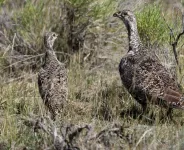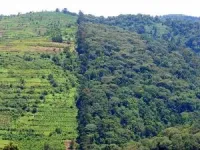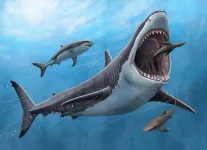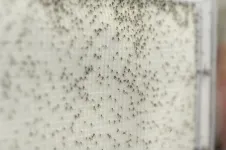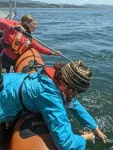(Press-News.org) Efforts to improve sage grouse habitat through conventional management practices may be ineffective -- and even counterproductive -- according to research by University of Wyoming and other scientists.
Sagebrush reduction strategies, including mowing and herbicide application, are often employed to enhance habitat for the greater sage grouse and other sagebrush-dependent species. The theory is that clearing large sagebrush shrubs improves food sources in sage grouse nesting and brood-rearing habitats by allowing other, more nutritious vegetation to grow with less competition. This, in turn, should increase invertebrate populations, another food source for sage grouse.
But a new paper published in the journal Wildlife Monographs suggests these methods may be misguided.
In a nine-year experimental study, researchers examined how sage grouse populations in central Wyoming responded to mowing and applying the herbicide tebuthiuron to Wyoming big sagebrush. According to their data, these treatments did not benefit the birds.
“Some managers think, ‘Treating sagebrush for wildlife is how it’s supposed to work, and we’ll keep doing it,’” says Jeff Beck, a UW professor of ecosystem science and management and principal investigator for the study. “Hopefully, this will get people to start thinking, ‘If we’re going to spend money to improve habitat, we’ve got to find some other ideas.’”
Beck’s co-authors include Kurt Smith, a former UW Ph.D. student who is now an ecologist with Western EcoSystems Technology; Jason LeVan, a former UW M.S. student who is now a range and wildlife conservationist for Pheasants Forever; Anna Chalfoun, a UW associate professor and assistant unit leader of the U.S. Geological Survey Wyoming Cooperative Fish and Wildlife Research Unit; Stanley Harter, a wildlife biologist with the Wyoming Game and Fish Department; Thomas Christiansen, a retired Wyoming Game and Fish Department sage grouse program coordinator; and Sue Oberlie, a retired Bureau of Land Management (BLM) wildlife biologist.
The researchers tracked behaviors and survival rates of more than 600 female greater sage grouse in response to mowing and tebuthiuron application. They also monitored effects on invertebrate populations, sagebrush and herbaceous vegetation. Throughout the study, responses were compared to untreated plots near the treated areas as well as off-site control plots.
Pretreatment data were collected from 2011-13; mowing and tebuthiuron applications were implemented in winter and spring 2014.
After six years (2014-19) of post-treatment monitoring, Beck and his colleagues determined that sage grouse responses to treatment were neutral at best.
“Neither mowing nor tebuthiuron treatments influenced nest success, brood success or female survival,” they reported.
Furthermore, treatments used to reduce Wyoming big sagebrush coverage resulted in slight avoidance by sage grouse.
Invertebrates and herbaceous vegetation also did not respond positively to reduction of Wyoming big sagebrush, indicating treatments did not improve the quantity and quality of sage grouse food sources.
Instead, reduction of Wyoming big sagebrush cover may negatively impact sage grouse and other species that use sagebrush shrubs to nest and seek refuge from predators, the researchers suggest.
They predict that expanding experimental treatments to larger areas may reveal greater negative effects of Wyoming big sagebrush reduction on sage grouse populations.
“Management practices that focus on the maintenance of large, undisturbed tracts of sagebrush will best facilitate the persistence of sage grouse populations and other species reliant on the sagebrush steppe,” they wrote.
Their results are consistent with many other studies suggesting that controlling Wyoming big sagebrush negatively impacts wildlife. However, they caution, their findings should not be generalized to other sagebrush species and subspecies, such as mountain big sagebrush.
Rather than removing Wyoming big sagebrush, Beck says, conservation strategies should focus on removing encroaching pinyon and juniper and invasive species such as cheatgrass. These types of vegetation alter the sagebrush ecosystem and influence fire cycles, potentially damaging sage grouse habitat.
Enhancing wet areas in sagebrush habitats is another promising strategy for improving the quality of sage grouse brood-rearing habitat, he notes.
To learn more about the study and its implications, call Beck at (307) 766-6683 or email jlbeck@uwyo.edu.
This research was supported by the Wyoming Game and Fish Department’s Wyoming Sage-grouse Conservation Fund; the Bates Hole, Big Horn Basin, South-Central, Southwest and Wind River/Sweetwater River local sage grouse working groups; the Wyoming Wildlife and Natural Resource Trust; the BLM’s Lander field office; the Margaret and Sam Kelly Ornithological Research Fund; and the Wyoming Reclamation and Restoration Center’s graduate assistantship program.
END
Research questions value of sagebrush control in conserving sage grouse
2023-06-26
ELSE PRESS RELEASES FROM THIS DATE:
Study: Potential new treatment identified for liver disease
2023-06-26
Researchers at the University of California San Diego School of Medicine have led a study to examine a potential new treatment option for patients with nonalcoholic steatohepatitis (NASH)-related fibrosis.
The results, published in the June 24, 2023, online edition of The New England Journal of Medicine, found that a drug that mimics a hormone in the body improved both liver fibrosis, or scarring of the liver, and liver inflammation in patients with NASH.
“Identifying an effective drug for NASH is extremely promising for patients as currently there are no FDA-approved therapies for this condition,” said Rohit Loomba, MD, the ...
Best papers of 2022 announced by SPIE Journal of Applied Remote Sensing
2023-06-26
BELLINGHAM, Washington, USA — The Journal of Applied Remote Sensing (JARS) has honored four of its best papers published in 2022. The awards recognize the journal’s best student paper, as well as papers in interdisciplinary applications, theoretical innovation, and photo-optical instrumentation and design.
JARS is published online in the SPIE Digital Library by SPIE, the international society for optics and photonics, and optimizes the communication of concepts, information, and progress among the remote-sensing ...
Study finds human impact on wildlife even in protected areas
2023-06-26
HOUSTON – (June 26, 2023) – By 2030, if the 30 by 30 initiative supported by more than 100 countries is successful, 30% of our land and ocean ecosystems will be designated protected areas meant to safeguard biodiversity and help limit the impacts of climate change.
However, a study by Rice University ecologist Lydia Beaudrot and collaborators reports for the first time that tropical mammals living inside protected areas are not spared the effects of human activity even when it occurs outside of the protected boundaries.
Based on the ...
University of Oklahoma researcher to use NSF CAREER Award to study local community's disaster resilience
2023-06-26
University of Oklahoma assistant professor Xiaochen (Angela) Zhang, Ph.D., has received a prestigious Faculty Early Career Development Award, known as a CAREER award, from the National Science Foundation to study how relationships among non-profits, community groups and local government agencies can improve disaster resilience, resource allocation, and emergency management by enabling organizational interactions, rather than top-down responses.
Zhang, who is an assistant professor of public relations for the Gaylord College ...
Research Brief: Investing in nature improves equity, boosts economy
2023-06-26
MINNEAPOLIS/ST. PAUL (06/26/2023) — A new study shows that current trends in environmental degradation will lead to large economic losses in the coming decades, hitting the poorest countries hardest. But there is hope: investing in nature can turn those losses into gains.
Researchers from the University of Minnesota and Purdue University published their findings in Proceedings of the National Academy of Sciences. The team developed a first-of-its-kind, global earth-economy model to capture interactions ...
New geochemistry research confirms megalodon shark was warm-blooded
2023-06-26
William Paterson University PRESS RELEASE
EMBARGOED UNTIL MONDAY, JUNE 26, 2023, 3:00 PM EST
WAYNE, NEW JERSEY — A new study shows that the gigantic Megalodon, or megatooth shark, was warm-blooded. This latest research on the Megalodon, which lived in the world’s oceans from 23 million to 3.6 million years ago and measured about 50 feet in length, appears in the peer-reviewed journal Proceedings of the National Academy of Sciences.
The study, conceived of and led by Michael Griffiths ...
Megalodon was no cold-blooded killer
2023-06-26
The largest marine predator that ever lived was no cold-blooded killer.
Well, a killer, yes. But a new analysis by environmental scientists from UCLA, UC Merced and William Paterson University sheds light on the warm-blooded animal’s ability to regulate its body temperature — and might help explain why it went extinct.
After analyzing isotopes in the tooth enamel of the ancient shark, which went extinct about 3.6 million years ago, the scientists concluded the megalodon could maintain a body temperature that was about ...
UCalgary study provides insight into how an infectious parasite uses immune cells as a Trojan Horse
2023-06-26
University of Calgary researchers have discovered how Leishmania parasites hide within the body to cause Leishmaniasis. The tiny parasites are carried by infected sand flies. Considered a tropical disease, one to two million people in more than 90 countries are infected every year. Effects range from disfiguring skin ulcers to enlarged spleen and liver and even death.
This chronic disease has been difficult to detect in the early stages. Scientists realized that the parasite was somehow manipulating immune cells but this process had not been well understood.
“This is the first study that shows how the parasite stalls the process of regular ...
Poop and prey help researchers estimate that gray whales off Oregon Coast consume millions of microparticles per day
2023-06-26
CORVALLIS, Ore. – Oregon State University researchers estimate that gray whales feeding off the Oregon Coast consume up to 21 million microparticles per day, a finding informed in part by poop from the whales.
Microparticle pollution includes microplastics and other human-sourced materials, including fibers from clothing. The finding, just published in the journal Frontiers in Marine Science, is important because these particles are increasing exponentially and predicted to continue doing so in the coming decades, according to researchers Leigh Torres and Susanne Brander.
Microparticle pollution is a threat to the health of ...
A smarter way to monitor critical care patients
2023-06-26
Surgical and intensive care patients face a higher risk of death and longer hospital stays because they are susceptible to both hypotension and hemodynamic instability – or unstable blood flow.
These potential complications require round-the-clock monitoring of several cardiac functions by nurses and physicians, but there’s currently no singular, convenient device on the market that can measure the most vital aspects of a patient’s cardiovascular health.
Ramakrishna Mukkamala, professor of bioengineering at the University of Pittsburgh Swanson School of Engineering, and Aman Mahajan, ...
